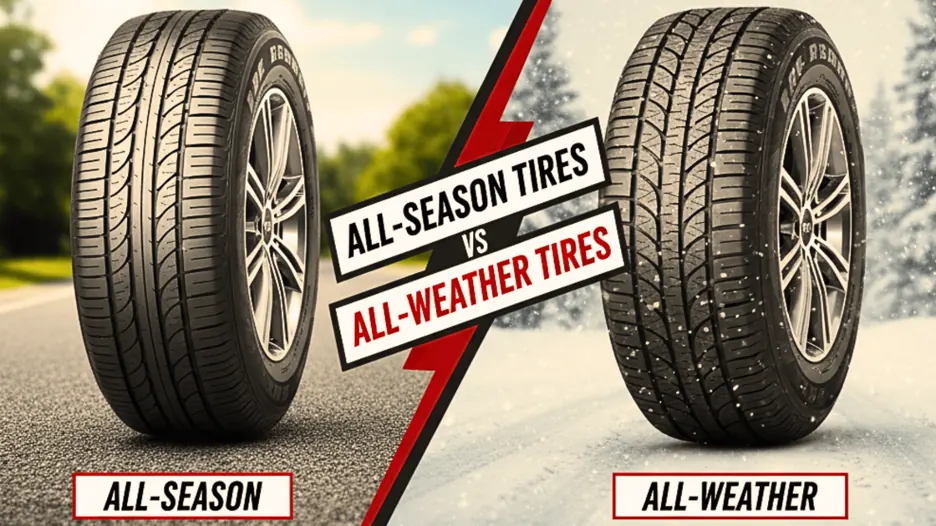
Are you part of the people who find it difficult to differentiate between all-season tires and all-weather tires? Or want to know the best for you among the two? You are not alone!
The words all-season and all-weather sound so much alike. However, these two types of tires are made to suit various driving conditions and the incorrect choice may influence the performance of your car, safety and your budget.
This guide breaks down the actual difference between all-season tires and all-weather tires in order to make the correct choice to use each depending on your daily driving situations.
The two types are cool, but with little differences to consider. All-season tires are suitable for drivers who live in mild climates and care about comfort and tread life. While all-weather tires are designed to work in colder areas or during occasional snowfall and also deliver consistent performance throughout the year without a change of sets.
It is up to you to figure out which one is best for your needs, according to your climatic conditions, driving style and comfort.
However, that’s not all. Let’s break it down a little bit further, so that you can easily make the best choice of the tire that fits your driving condition.
What Are All-Season Tires?
All-season tires are designed to provide the driver with consistent performance in various daily conditions like wet roads, dry roads, and cold weather.
Most new cars already have it fixed in the car from the production factory because they are comfortable, durable and fuel efficient.
The name all-season can be sometimes deceptive. Originally, It means that the tire is good in all seasons, which is not totally true.
All-season tires are most effective when the temperatures are above 45°F (7°C). Beyond that, the rubber becomes hardened, decreasing its flexibility and grip.
Once the rubber hardens, it will no longer have traction on an icy road or snowy road, and therefore, the moderate conditions of winter will make your car feel off-balance on the road or less responsive.
This explains that all-season tires are best used in areas with mild winters, areas where roads rarely freeze, and snow is not common.
In short, all-season tires are suitable in cases where the driver is not in regular winter conditions, gets warm and moderate temperatures with few rainy or cool weather.
What Are All-Weather Tires?
All-weather tires were created to fill the gap between all-season tires and winter tires. They are designed to suit drivers in changing weather conditions like frosty mornings, or sudden rain, or even a temporary snowstorm.
The main distinction is in the way they are constructed. All-weather tires contain a rubber compound that makes them flexible, even in temperatures that are below the freezing point.
This flexibility will assist in retaining a good grip and effective braking during winter seasons.
They also had a more aggressive tread pattern and deeper grooves and additional biting edges that assist the tire in digging into slush or light snow.
Nevertheless, they work well even on dry roads, which makes them good enough to be used throughout the year.
The simplest method of identifying an all-weather tire is to find the Three Peak Mountain Snowflake (3PMSF) emblem on the sidewall of the tire.
This certification indicates that the tire was tested and it provides at least 10 percent greater snow traction as compared to a regular all-season tire.
All these properties make all-weather tires a great choice for people who do not like the idea of replacing tires in every season, yet, want a high level of reliability during the cold weather.
Key Differences between All-Weather and All-Season tires.
Even though both types are intended to be used all year round, their performance and capabilities are substantially different.
| All-Season Tires | All-Weather Tires | |
| Temperature Range | Best above 45°F (7°C) | Performs well in both warm and cold |
| Snow & Ice Performance | Limited traction | Designed for snow and light ice |
| Tread Design | Smooth and optimized for dry/wet roads | Deeper tread with more grip edges |
| Flexibility | Stiffens in cold temperatures | Stays flexible in cold |
| 3PMSF Symbol | No | Yes |
| Ideal Driver | Lives in a mild climate | Faces mixed or unpredictable weather |
Basically, the table implies that all-weather tires are able to cope with everything that all-season tires are, and beyond. They are meant to remain stable during unpredictable weather conditions.
All-weather tires will be reasonable if you reside somewhere with hot summers, cool autumns, and snowy winters. However, in an area where winter hardly gets low enough to freeze, you will probably be okay with all-season tires.
The M+S Symbol (Common Misconception)
A lot of tires have the M+S symbol written on them. This is an acronym that means Mud and Snow. One might think that it implies that the tire is suitable for winter, but that is not totally the case.
The M+S marking does not imply that the tire tread pattern is tested or approved to perform in the snow. The only thing it signifies is that the tire tread pattern has wider grooves.
To be able to handle winter, you need the 3PMSF symbol that guarantees enhanced snow and ice traction.
How to Choose the Right Tire for Your Needs
Choosing the right tire for your needs will be based on your geographical weather conditions and driving patterns.
All-season tires are the most economical in case you reside in a region that has moderate winters with rare snow. They provide a comfortable and quiet ride, long life of treads and an improvement in fuel economy.
In situations where you have to deal with cold mornings on a regular basis, wet roads, or unpredictable seasonal weather, the all-weather tires will be a good investment.
The all-weather tire saves you that inconvenience of having to switch your winter tires every year, and also improves your safety in any weather below the freezing point.
Even in regions with long and severe winters, drivers will still have to consider special winter tires.
In short, all-weather tires are the best balance between performance and convenience for most individuals with mixed climates.
Conclusion
All-season tires and all-weather tires seem to be identical to each other, but it is their performance that makes them different. One is more comfortable and long-lasting in the case of light climatic conditions, whereas the other is safer and more reliable in the variable or low temperatures.
It is not only a matter of cost when it comes to making the choice between them, but also knowing how your tires will behave when the road conditions vary.
When you know your local weather and your driving habits, then it is evident what type of tires you need. By doing that, you will drive more safely, more re-assuredly and know that the tires are doing their job exactly what they are supposed to do, to keep you safe throughout the year.



